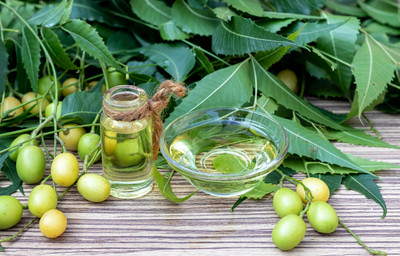Neem: The Healing Tree with Ayurveda Origins
Klaus Ferlow. HMH, HA, NEEM RESEARCH, Roberts Creek, B.C., Canada, on Mar 11th 2024

Every part of the neem tree – bark, cake, flower, fruit, gum, honey, leaves, pulp, resins, root, seed oil, twigs – has medicinal value
What makes the neem tree worthy to be named Tree of the 21st Century? For thousands of years, humans have sought to fortify their health and cure various ills with herbal remedies. The search for the true panacea, or cure-all, has been undertaken by virtually every civilization. While hundreds of substances have been tried and tested, few have truly withstood modern science scrutiny.
In my view, no other botanical better meets the true definition of a panacea than the neem tree (botanical name Azadirachta indica A.Juss), a tropical evergreen belonging to the mahogany family. This tree is native to India and Myanmar with a history of 4,500 years and is part of the oldest and most successful botanical medical system in the world, Ayurveda.
In India, Ayurveda is known as the science of life (ayus “life” and veda “science) and has a 5,000 year history . It is also called “The Village Pharmacy.” Neem is known as sarva roga nivarin or “healer of all ailments.” The life of neem is named “Arista” in Sanskrit – meaning perfect, complete and imperishable!

Medicinal ayurvedic azadirachta indica or Neem leaves and flowers. Very powerful Indian medicinal tree.
Every part of this fascinating and versatile medicinal tree has been used by Ayurvedic physicians – from ancient to modern times – to treat hundreds of maladies because it offers better plant, human, animal, and environmental health.
While other herbs such as ginseng are better known, research has shown that neem has a wider array of uses than any other botanical medicine. While it has always been revered in India, new studies have significantly increased worldwide interest in neem, leading to new herbal products being manufactured and distributed.
Two world renowned entomologists and neem researchers, Professor Dr. Heinrich Schmutterer of Germany and Dr. Ramesh Saxena of India, have played a major role in the rediscovery of the benefits and healing power of this remarkable tree.
Neem Medicine Gains Popularity Worldwide
Well known corporations including Costco, Colgate, Now Foods, Sundari, New Roots Herbal, Nature’s Way, Walmart, Whole Foods Market, Dr. Hauschka (Germany), Avon (UK), A. Vogel (Switzerland), and Shiseido (Japan) have jumped on the bandwagon and are now utilizing and selling herbal medicinal neem products through Amazon and AliBaba. A worldwide NEEM WAVE has taken place and more companies will follow!
The first recorded use of neem was several thousand years ago, when ancient Indian cultures used it in health and beauty aids. Medicinal attributes of neem were extolled in the oldest Sanskrit writings. No wonder the United Nations declared the neem tree to be “The tree of the 21st century.”
It is only in recent years that the rest of the world has shown interest in neem’s versatility and potential. International scientific research has explored neem’s ability to prevent and treat an astonishing number of health disorders, including those not successfully addressed by conventional pharmaceuticals!

Klaus Ferlow with his beloved neem trees
Every part of the neem tree – bark, cake, flower, fruit, gum, honey, leaves, pulp, resins, root, seed oil, twigs – has medicinal value. Neem trees help prevent environmental pollution and soil erosion, and they rehabilitate degraded ecosystems and wastelands. Neem trees are recommended for reforestation, are useful for wind breaks in areas of low rainfall and high-speed wind, they protect crops, and can be made into non-toxic pesticides. The neem plant is also used in veterinarian medicine, cosmetics, and personal care products.
My own experience with neem has been nothing short of miraculous. I suffered for more than 40years with severe psoriasis on my scalp and elbows. However, when I started using the neem cream, shampoo, conditioner, oil, soap and tincture manufactured by my company Ferlow Botanicals, I found myself free of psoriasis.
Of all botanical plants that have been proven useful throughout the ages, few have offered as much value and versatility as the neem tree. It is truly ancient medicine for a modern world. Human ingenuity has led to wondrous feats, from fire to complex social structure. The challenge before us now is to link the wisdom of our past with current knowledge and technology to find ecologically sound solutions to emerging global issues such as climate change and pollution.
Author bio: Klaus Ferlow is an author, fourth generation herbalist, educator, formulator, innovator, lecturer, researcher, writer, founder of Ferlow Botanicals 1993, and NEEM RESEARCH, 2013. He is also a core-founding member of the WNO – World Neem Organization, Mumbai, India, 2017, and member of the International Herb Association, United Plant Savers, Canadian Herbalist’s Association of B.C., co-author of the book “7 Steps to Dental Health” 2010, and author of the book “Neem: Nature’s Healing Gift to Humanity,” 2015. The third edition of his book and the new book “Neem: The Tree that heals Nations” will be released early 2024.

The book received the GOLD MEDAL at the 2019 annual Living Now Book Awards in the category “Health & Wellness” by the Jenkins Group & Independent Publishers, Traverse City, MI
http://neemresearch.ca/klaus-ferlow-curriculum-vitae, www.worldneemorganisation.org, neempedia.com,
https://neem.world, https://www.ferlowbotanicals.com
neemresearch.ca/neem-research-
Disclaimer: The article is only for educational purposes and should not be used to diagnose, cure or treat disease. Please contact your health care practitioner!



